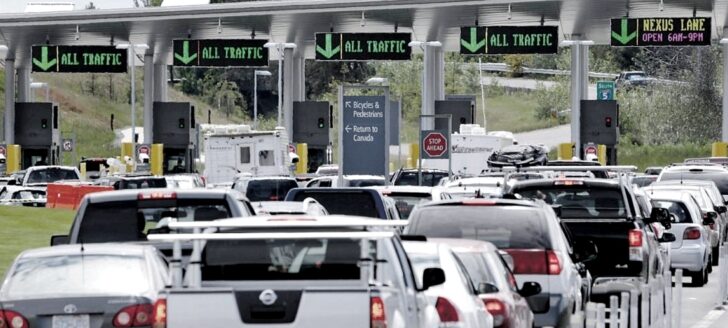Some of the very best hunting and fishing in North America can be found in Canada. However, our brother to the North does not have the same thoughts about firearms as we do. As a point of curiosity, we decided to investigate what it would take to bring our everyday carry (EDC) firearms across the border.
Fun Fact: There are over 1.9 million licenses to possess firearms and of those issued, only 22,000 have been revoked by the Royal Canadian Mounted Police (RCMP). For comparison, there’s an estimated more than 8 million concealed carry permit holders* in the United States.
*Tabulated from numbers given by active permits in “States’ Laws and Requirements for Concealed Carry Permits Vary Across the Nation”, July, 2012, Government Accountability Office (GAO), Page 80.
Introduction To Canadian Firearms And Permitting
The majority of licensed firearms in Canada are predominantly hunting rifles and shotguns. For those few who own and operate full size handguns, those are generally classified by Canada as “restricted firearms”. Concealed carry permits are not issued to non-residents and it would be extremely hard to find a Canadian that’s not a member of a Canadian law enforcement agency who has one.
There are three basic types of permitting available to residents:
- PAL – Possession and Acquire License
- POL – Possession Only License
- Minor – For those under 18.
In both PAL and POL, the permit holder can legally possess a non-restricted firearm and ammunition. The PAL is the only permit, at this time, issued to first time applicants and can only be acquired after completing an approved Canadian Firearms Safety Course.
Notable conditions of a restricted firearm include:
- Handguns with barrels of a length equal or greater than 4.1″ (105 mm)
- Handguns that don’t use .25 or .32 caliber ammunition – with exceptions for competitive shooting models
- Semi-automatic, center-fire rifles and shotguns with a barrel shorter than 18.5″ (470 mm)
- Rifles and shotguns that can be fired when their overall length has been reduced by folding, telescoping, etc., to less than 26″ (660 mm)
Handgun magazines that hold more than 10 rounds and center-fire semi-automatic rifles that hold more than 5 rounds are prohibited by Canadian law.
Transporting Firearms Across The Canadian Border
For Non-Residents, it’s possible to not only transport firearms across the border but even acquire a 5 year Possession and Acquire License (PAL). A non-resident would have to complete the Canadian Firearms Safety Course prior to applying for his PAL.
For pistols that aren’t prohibited, a non-resident needs:
- Authorization to Transport (ATT, RCMP 5491)
This has to be approved by the Chief Firearms Officer (CFO) of the province in which the firearm will be located. The Canadian Embassy has repeatedly noted that “self defense” and “hunting purposes” will probably not be acceptable answers.
This is a form that HAS to be approved prior to transporting a pistol across the border.
At the border, you’ll need:
- Non-Resident Firearm Declaration (RCMP 5589)
- (For more than 3 firearms) Non-Resident Firearm Declaration Continuation Page (RCMP 5590)
- Properly authorized Authorization to Transport (ATT)
These forms should be filled out prior to arriving in Canada but should not be signed until under the supervision of Canadian authorities.
A Non-Resident Firearms Declaration covers you for no more than 60 days. It’s recommended that if you intend on staying in Canada with your firearm for longer than that, you should complete the Canadian Firearms Safety Course and then apply for a PAL.
Concealed Carrier Be Warned!
If you deny you have a weapon at the border or do not have authorization to transport into Canada – those weapons will be seized and permanently forfeited. And unlike the civil forfeiture proceedings in the United States, there is zero chance of ever recovering them again. The Canadian government may prosecute you and fine you heavily or worse – they send you back to the United States to face serious consequences.
The Canadians take gun control very seriously. Do not dink with them.
Driving Around With Firearms In Canada
If you have a restricted firearm (such as a handgun) in the vehicle with you, it must be unloaded and have an approved gun safety lock to ensure it cannot discharge. It should be stored in a lockable container and ammunition must be stored outside of the firearm. They can both be located inside the same lockable case.
If you exit the vehicle, that firearm needs to be locked and stored outside of plain sight.
If you leave the province where you received Authorization To Transport, you must have authorization from the CFO of the province you’re visiting in order to keep the firearm with you. And if you can’t take the firearm with you, you will need to store it in a gun safe.
“What If I’m Just Trying To Get To Alaska With My Conceal Carry Handgun?”
The Canadian Embassy strongly suggests you ship your firearms by an approved Firearms Act transport method to someone with a Federal Firearms License in Alaska. (We have a forthcoming article detailing how to mail a firearm.)
And the Canadian Embassy is right. It would be far simpler to mail your firearms to Alaska rather than transport them yourself. Plus, there are a lot fewer restrictions on what can be shipped versus what can be transported by you – a non-resident.
Brass Tax (TL;DR): If you’re a handgun owner in the United States and you want to bring your handgun with you to Canada, the biggest constraint is going to be getting ATT approval. ATT approval means coming up with a reason other than “self defense” and “hunting” – even though both are extremely valid reasons in the mind of any concealed carrier. Shooting competitions appear to be the most acceptable reason.

